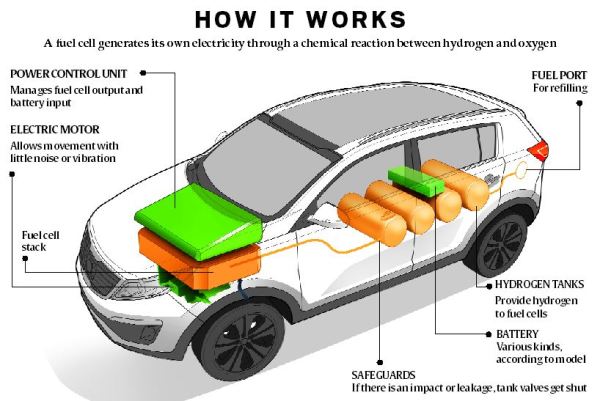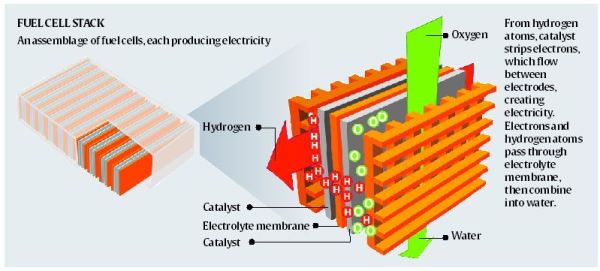 Supreme Court has asked government to look into the feasibility of hydrogen-based tech to deal with vehicular air pollution in capital. India is looking closely at Japan, which has made progress in this field.
Supreme Court has asked government to look into the feasibility of hydrogen-based tech to deal with vehicular air pollution in capital. India is looking closely at Japan, which has made progress in this field.
Ahead of next July’s Tokyo Olympics, Japan is gearing up to put on its roads thousands of vehicles based on a hydrogen cell technology, also known as ‘fuel cells’. Japan’s lead in the practical application of the hydrogen fuel cycle, and the ongoing research in this field at the International Research Center for Hydrogen Energy at Kyushu University, are being studied closely by the Indian government as it readies a hydrogen-fuelled blueprint. This comes in the backdrop of the Supreme Court directing the government on November 13 to look into the feasibility of introducing such technology to deal with air pollution in the National Capital Region.
View our Blog: https://ensembleias.com/blog/
How does the hydrogen fuel cell work?
At the heart of the fuel cell electric vehicles (FCEV) is a device that uses a source of fuel, such as hydrogen, and an oxidant to create electricity by an electrochemical process. Put simply, the fuel cell combines hydrogen and oxygen to generate an electric current, water being the only byproduct. Like conventional batteries under the bonnets of automobiles, hydrogen fuel cells too convert chemical energy into electrical energy. From a long-term viability perspective, FCEVs are billed as vehicles of the future, given that hydrogen is the most abundant resource in the universe.

So is an FCEV a conventional vehicle or an electric vehicle (EV)?
While the fuel cells generate electricity through an electrochemical process, unlike a battery-electricity vehicle, it does not store energy and, instead, relies on a constant supply of fuel and oxygen — in the same way that an internal combustion engine relies on a constant supply of petrol or diesel, and oxygen. In that sense, it may be seen as being similar to a conventional internal combustion engine.
But unlike the combustion engine cars, there are no moving parts in the fuel cell, so they are more efficient and reliable by comparison. Also, there is no combustion onboard, in the conventional sense.
Visit our store at http://online.ensemble.net.in
Globally, EVs are bracketed under three broad categories:
* BEVs such as the Nissan Leaf or Tesla Model S, which have no internal combustion engine or fuel tank, and run on a fully electric drivetrain powered by rechargeable batteries.
* Conventional hybrid electric vehicles or HEVs such as the Toyota Camry sold in the country combine a conventional internal combustion engine system with an electric propulsion system, resulting in a hybrid vehicle drivetrain that substantially reduces fuel use. The onboard battery in a conventional hybrid is charged when the IC engine is powering the drivetrain.
* Plug-in hybrid vehicles or PHEVs, such as the Chevrolet Volt, too have a hybrid drivetrain that uses both an internal combustion engine and electric power for motive power, backed by rechargeable batteries that can be plugged into a power source.
* FCEVs are widely considered to be the next frontier in EV technology. FCEVs such as Toyota’s Mirai and Honda’s Clarity use hydrogen to power an onboard electric motor. Since they are powered entirely by electricity, FCEVs are considered EVs — but unlike BEVs, their range and refuelling processes are comparable to conventional cars and trucks.

To what uses can the technology be put?
The hydrogen fuel cell vehicle market is dominated by Japan’s Toyota and Honda, alongside South Korea’s Hyundai. While the successful development of hydrogen would provide energy for transportation and electric power, an advantage is the wide availability of resources for producing hydrogen.
Japan’s Ministry of Economy, Trade and Industry (METI) published a ‘Strategic Roadmap for Hydrogen and Fuel Cells’ in 2014, with a revised update in March 2016, with a goal to achieve a hydrogen society. Stationary fuel cells — the largest, most powerful fuel cells — are being designed to provide a cleaner, reliable source of on-site power to hospitals, banks, airports and homes. A fuel cell continues to produce energy as long as fuel and oxidant are supplied. Portable fuel cells could find other applications beyond vehicles.
Roger Hertzenberg, CEO of Uno-X Hydrogen, which develops hydrogen stations in Norway, the world leader in green vehicle technology, told The Indian Express: “Fuel cell electric vehicles are the most user-friendly zero-emission solution in Norway. Our goal is to provide the necessary infrastructure, securing our customers several zero emission-alternatives to choose from, and to meet the demand for H2 fuel in a convenient way at the lowest possible cost for the consumer.”
What are the advantages and disadvantages of fuel cells?
Fuel cells have strong advantages over conventional combustion-based technologies currently used in many power plants and cars, given that they produce much smaller quantities of greenhouse gases and none of the air pollutants that cause health problems. Also, if pure hydrogen is used, fuel cells emit only heat and water as a byproduct. Such cells are also far more energy efficient than traditional combustion technologies.
Unlike battery-powered electric vehicles, fuel cell vehicles do not need to be plugged in, and most models exceed 300 km of range on a full tank. They are filled up with a nozzle, just like in a petrol or diesel station.
But there are problems.
While FCEVs do not generate gases that contribute to global warming, the process of making hydrogen needs energy — often from fossil fuel sources. That has raised questions over hydrogen’s green credentials.
Also, there are questions of safety — hydrogen is more explosive than petrol. Opponents of the technology cite the case of the hydrogen-filled Hindenburg airship in 1937. But Japanese auto industry players The Indian Express spoke to argued that a comparison was misplaced because most of the fire was attributed to diesel fuel for the airship’s engines and a flammable lacquer coating on the outside.
Hydrogen fuel tanks in FCEVs such as the Mirai are made from highly durable carbon fibre, whose strength is assessed in crash tests, and also trials where bullets are fired at it. The Mirai and Clarity have a triple-layer hydrogen tanks made of woven carbon fibre, which the manufacturers claim is completely safe.
The other major hurdle is that the vehicles are expensive, and fuel dispensing pumps are scarce. But this should get better as scale and distribution improves.
Japan is going full steam ahead. Prime Minister Shinzo Abe declared in Davos this year that Japan “aims to reduce the production cost of hydrogen by at least 90 per cent by the year 2050, to make it cheaper than natural gas”.
What is the progress in India?
In India, so far, the definition of EV only covers BEVs; the government has lowered taxes to 12%. At 43%, hybrid electric vehicles and hydrogen FCEVs attract the same tax as IC vehicles.
The Ministry of New and Renewable Energy, under its Research, Development and Demonstration (RD&D) programme, has been supporting various such projects in academic institutions, research and development organisations and industry for development. Fourteen RD&D projects on hydrogen and fuel cells are currently under implementation with the support of the Ministry. Between 2016-17 and 2018-19, eight projects were sanctioned and 18 completed.
The Ministry of Science and Technology has supported two networked centres on hydrogen storage led by IIT Bombay and Nonferrous Materials Technology Development Centre, Hyderabad. These involve 10 institutions, including IITs, and IISc, Bangalore.
Source:Indian express | Written by Anil Sasi
For more details : Ensemble IAS Academy Call Us : +91 98115 06926, +91 6232282596
Email: [email protected] https://ensembleias.com/
#hydrogen_fuel #hydrogen #hydrogen_car #hybrid_electric_vehicles #geography_optional #upsc2020 #ias #k_siddharthasir #Government_of_India #india #studyabroad #geography #upsc #bhugol #government #news #dailynews #gk #dailyquiz #editorial




